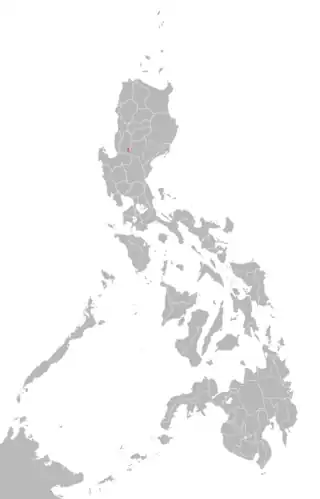Iwaak language
Iwaak (also spelled I-wak or I'wak) is a South-Central Cordilleran language spoken by almost 3,300 people around the Cordillera Central mountain range of Luzon, Philippines. It is a Pangasinic language which makes it closely related to Pangasinan, one of the regional languages in the country, with around 1.2 million speakers.
| Iwaak | |
|---|---|
| I-wak | |
| Native to | Philippines |
| Region | Luzon |
Native speakers | 3,300 (2000)[1] |
Austronesian
| |
| Language codes | |
| ISO 639-3 | iwk |
| Glottolog | iwak1237 |
 Area where Iwaak is spoken according to Ethnologue | |
According to Ethnologue, in eastern Itogon municipality, Benguet Province, I-wak is spoken in Tojongan, Bakes, Lebeng, Domolpos, Bujasjas, and Kayo-ko villages. It is also spoken in Salaksak village, Kayapa municipality, Nueva Vizcaya Province.
References
- Iwaak at Ethnologue (18th ed., 2015) (subscription required)
| Official languages | |
|---|---|
| Regional languages | |
| Indigenous languages (by region) | |
| Immigrant languages | |
| Sign languages | |
| Historical languages | |
| Batanic (Bashiic) | |||||||||||||||||||||||||
|---|---|---|---|---|---|---|---|---|---|---|---|---|---|---|---|---|---|---|---|---|---|---|---|---|---|
| Northern Luzon |
| ||||||||||||||||||||||||
| Central Luzon |
| ||||||||||||||||||||||||
| Northern Mindoro | |||||||||||||||||||||||||
| Greater Central Philippine |
| ||||||||||||||||||||||||
| Kalamian | |||||||||||||||||||||||||
| Bilic | |||||||||||||||||||||||||
| Sangiric | |||||||||||||||||||||||||
| Minahasan | |||||||||||||||||||||||||
| Other branches |
| ||||||||||||||||||||||||
| Reconstructed | |||||||||||||||||||||||||
| |||||||||||||||||||||||||
This article is issued from Wikipedia. The text is licensed under Creative Commons - Attribution - Sharealike. Additional terms may apply for the media files.